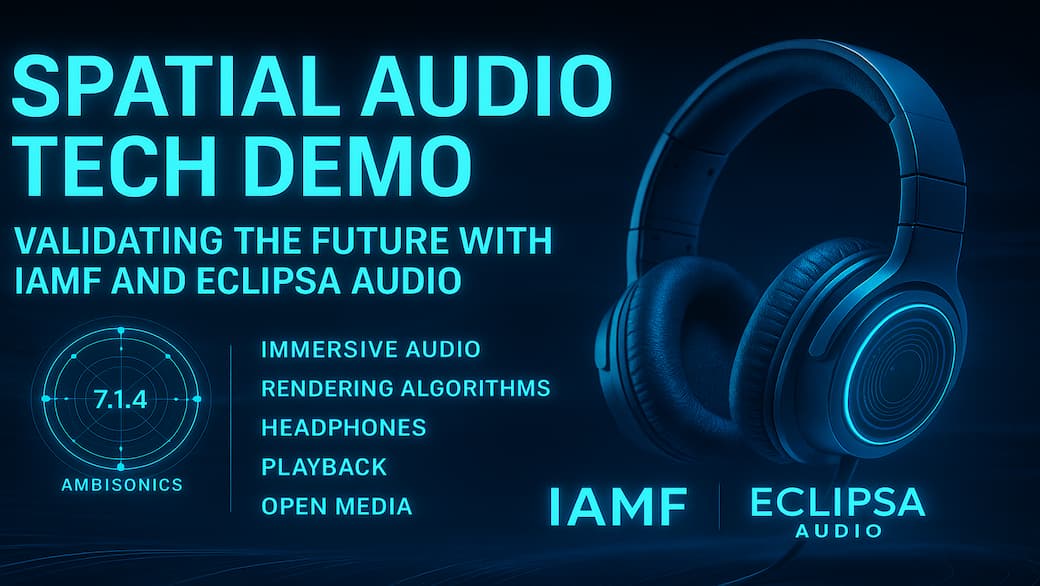
Immersive Audio Demo: Test IAMF Spatial Sound on YouTube
Content
Immersive Audio Demo: Test IAMF Spatial Sound on YouTube
Immersive audio, including dolby atmos, is on the rise — but while the buzzwords multiply, actual tools to test and validate these new formats remain rare. That’s where this project comes in: a practical, reproducible tech demo designed to showcase how spatial audio can already be experienced today using open tools, real multichannel formats, and forward-looking standards.
IAMF (Immersive Audio Model and Formats) may still be new to most content creators, but it represents a new generation of audio formats — open, scalable, and codec agnostic. It’s being developed by Google, Samsung, and the Alliance for Open Media, and is already supported on emerging platforms under the branding Eclipsa Audi. Eclipsa Audio is also integrated into the Samsung Crystal UHD series, delivering immersive 3D sound and enhancing the viewing experience on these TVs.
But does it actually work in the real world?
This demo proves: Yes, it does. The technologies showcased here enhance the immersive experience for viewers, whether they’re enjoying TV, gaming, or film content.

Two Formats, One Goal: Spatial Accuracy
To evaluate the state of immersive audio today, I’ve created two separate demo files using the IAMF specification. Each file serves as an instance of immersive audio content, demonstrating different approaches to content creation and showcasing how IAMF technology creates realistic, spatial soundscapes.
1. Channel-Based 7.1.4 Audio Signal
This test uses a traditional speaker layout including front, side, and top speakers — allowing a full horizontal and vertical rendering of a soundfield. It’s designed to validate:
-
Channel mapping and routing
-
Audio levels and speaker balance
-
mmersive playback over multiple devices including TV, soundbars, and headphones
This format mimics home cinema installations and aims to provide creators and device manufacturers with a way to test their IAMF integration on real-world hardware — including premium platforms like Neo QLED 8K.
2. Third-Order Ambisonics with Head-Locked Layer
This second test explores spatial audio more radically:\ A 16-channel Third-Order Ambisonic (TOA) bed that simulates full 360° sound movement — in azimuth and elevation — combined with a head-locked stereo layer for fixed-position elements, similar to the effect created by 8D audio.
Why this matters:
-
It tests the IAMF format’s scene-based audio support
-
It demonstrates spatial reflections, spatial depth, and the difference between diegetic and non-diegetic sounds
-
It helps validate rendering algorithms that respond differently across headphones, TVs, or streaming services
Together, these two demos allow direct comparison between channel-based formats and ambisonics, using identical source material, but encoded differently.
A Soundcheck for the New Audio Model
IAMF isn’t just another format — it’s a flexible audio model and format that supports creating immersive audio experiences across diverse playback environments.
By encoding and testing these files manually, I was able to simulate workflows that, in the future, will be supported natively by media platforms and streaming services. Until then, this kind of test is essential for creators and engineers looking to:
-
Experiment with open source audio format pipelines
-
Create spatial audio content without being locked into proprietary ecosystems
-
Tune and optimize playback across various devices
-
Delivering immersive audio by automatically analyzing sound segments and delivering dynamic, spatial audio tailored to the listener’s environment, ensuring clear positioning and presence
Eclipsa soundcheck files:
https://1drv.ms/f/c/648c537d9dce7641/EifsBwSczW5PjSmLMLkeRKoBW7Bjr7IBQMv2fL1g-lmOeQ?e=Mdx2NJ
The Process Behind the Test
These demos were created using open media tools like FFmpeg, and follow the latest IAMF guidelines for integrated loudness, digital peaks, and channel layout compliance.
The files are available for testing on:
-
VLC Player (IAMF experimental build)
-
The YouTube App on Eclipsa Audio-compatible devices
These platforms include a range of consumer electronics, such as mobile devices and TVs, where Arm-based hardware plays a key role in optimizing playback and immersive audio performance.
Browser-based playback currently downmixes to stereo — not ideal for validation. For correct multi-format rendering, use platforms that fully support IAMF.
Open Source Audio: Powering Innovation in Spatial Sound
The Alliance for Open Media has emerged as a driving force behind the evolution of immersive audio, championing open-source solutions that are reshaping how we experience sound. At the heart of this movement is the Immersive Audio Model and Formats (IAMF), an open-source audio format designed to unlock the full potential of spatial audio for professionals and everyone.
IAMF represents a major leap forward in audio technology, offering a flexible and scalable audio model and format that empowers creators to deliver high-quality, immersive audio experiences across a vast array of devices. Its open-source foundation means that device manufacturers and content platforms can adopt and implement IAMF without barriers, accelerating innovation and ensuring that immersive audio is not limited to a select few.
By embracing open media standards like IAMF, the industry is witnessing a surge in new technologies—ranging from advanced rendering algorithms to dynamic spatial reflections—that enhance the depth and realism of audio. This collaborative, open-source approach is fueling a new generation of immersive audio experiences, allowing listeners to experience sound with unprecedented clarity, spatial depth, and intensity.
The Alliance for Open Media’s commitment to open-source development has been instrumental in this progress. By providing a platform for the creation and promotion of open audio formats, the alliance is enabling rapid advancements in immersive audio models and formats. As demand for immersive audio continues to grow, the importance of open-source innovation will only increase, shaping the future of how we create, deliver, and experience sound.
In short, IAMF and the Alliance for Open Media are powering a wave of innovation that is making immersive audio more accessible, flexible, and engaging than ever before—setting the stage for the next era of audio technology.

Device and Platform Support: Bringing Immersive Audio to Everyone
One of the standout strengths of IAMF is its ability to deliver immersive audio experiences seamlessly across a diverse range of devices and media platforms. Whether you’re listening on a smartphone, watching a movie on a premium flagship Neo QLED TV, gaming on a console, or streaming music through your favorite service, IAMF ensures that immersive audio is within reach.
Thanks to its codec-agnostic design, IAMF can be integrated with a variety of existing and emerging audio formats, making it a versatile choice for device manufacturers and content platforms alike. This flexibility has led to widespread support, with leading brands and streaming services adopting IAMF to enhance their audio offerings and provide listeners with richer, more dynamic soundscapes.
For content creators, this means the freedom to produce immersive audio content that can be enjoyed on virtually any device—without worrying about compatibility or proprietary limitations. IAMF’s broad platform support extends to music, TV, gaming, and video-on-demand, ensuring that immersive audio experiences are accessible to a global audience.
As more devices and platforms embrace IAMF, the immersive audio landscape is rapidly expanding. Listeners can now experience sound that matches the intensity and realism of the original mix, regardless of where or how they choose to listen. This democratization of immersive audio is driving innovation across the industry, setting new standards for quality and accessibility.
With IAMF at the forefront, the future of immersive audio is bright—bringing the magic of spatial sound to everyone, everywhere, and inspiring a new wave of creativity and engagement in the audio world.
From Las Vegas to Your Living Room
First introduced publicly at CES in Las Vegas, Eclipsa Audio is gaining traction as a technology suite built around IAMF, delivering cutting-edge audio innovation at the edge of device ecosystems. It is already being integrated into high-end consumer electronics and will likely define how we experience sound in future TV, gaming, and movie content.
But adoption depends on confidence — and confidence comes from testing, so stay tuned .
This demo is a real-world proof-of-concept that spatial formats like 7.1.4 and Ambisonics can already be used today, encoded and played back with open tools, and scaled across platforms.

Final Thoughts
This is more than just a sound demo. It’s a step toward a more transparent, accessible, and open-source audio future — where immersive audio experiences aren’t locked behind paywalls or proprietary licenses.
IAMF represents a shift in how we think about sound: not just louder, but deeper, more dynamic, and truly spatial.
Whether you’re a content creator, engineer, or just a curious listener — this demo is your invitation to experience sound differently.
Contact me if you’d like to test the original files. The tools may be early, but the result is clear:
Spatial audio already works — and it sounds incredible.
Related Articles
YouTube and 3D Audio – More Than Dolby Atmos?
Eclipsa Audio for YouTube vs Dolby 3D Sound fails, because...
Eclipsa Immersive Audio Model and Formats for YouTube Atmos
Ambisonic for Virtual Reality and 360° Soundfield
Head Tracked Spatial Audio vs Fixed: Mix with the Head-Locked Stereo